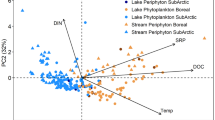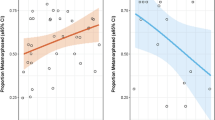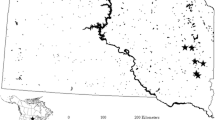Abstract
Primary producers form the base of food webs but also affect other ecosystem characteristics, such as habitat structure, light availability, and microclimate. Here, we examine changes caused by 5–30+ years of nutrient addition and resulting increases in net primary productivity (NPP) in tundra, streams, and lakes in northern Alaska. The Arctic provides an important opportunity to examine how ecosystems characterized by low diversity and low productivity respond to release from nutrient limitation. We review how responses of algae and plants affect light availability, perennial biotic structures available for consumers, oxygen levels, and temperature. Sometimes, responses were similar across all three ecosystems; e.g., increased NPP significantly reduced light to the substrate following fertilization. Perennial biotic structures increased in tundra and streams but not in lakes, and provided important new habitat niches for consumers as well as other producers. Oxygen and temperature responses also differed. Life history traits (e.g., longevity) of the primary producers along with the fate of detritus drove the responses and recovery. As global change persists and nutrients become more available in the Arctic and elsewhere, incorporating these factors as response variables will enable better prediction of ecosystem changes and feedbacks in this biome and others.


Similar content being viewed by others
References
Antón A, Cebrian J, Heck KL, Duarte CM, Sheehan KL, Miller ME, Foster CD (2011) Decoupled effects (positive to negative) of nutrient enrichment on ecosystem services. Ecol Appl 21:991–1009
Arctic LTER Database. http://arc-lter.ecosystems.mbl.edu/data-catalog
Arscott DB, Bowden WB, Finlay JC (1998) Comparison of epilithic algal and bryophyte metabolism in an arctic tundra stream, Alaska. J N Am Benth Soc 17:210–227
Bartels P, Cucherousset J, Steger K, Eklöv P, Tranvik LJ, Hillebrand H (2012) Reciprocal subsidies between freshwater and terrestrial ecosystems structure consumer resource dynamics. Ecology 93:1173–1182
Batzli GO, Lesieutre C (1995) Community organization of arvicoline rodents in north Alaska. Oikos 72:88–98
Benstead JP, Deegan LA, Peterson BJ, Huryn AD, Bowden WB, Suberkropp K, Buzby KM, Green AC, Vacca J (2005) Responses of a beaded Arctic stream to short-term N and P fertilization. Freshw Biol 50:277–290
Benstead JP, Green AC, Deegan LA, Peterson BJ, Slavik K, Bowden WB, Hershey AE (2007) Recovery of three arctic stream reaches from experimental nutrient enrichment. Freshw Biol 52:1077–1089
Bettez ND, Rublee PA, O’Brien J, Miller MC (2002) Changes in abundance, composition and controls within the plankton of a fertilised arctic lake. Freshw Biol 47:303–311
Boelman NT, Stieglitz M, Rueth HM, Sommerkorn M, Griffin KL, Shaver GR, Gamon JA (2003) Response of NDVI, biomass, and ecosystem gas exchange to long-term warming and fertilization in wet sedge tundra. Oecologia 135:414–421
Boelman NT, Gough L, Wingfield J, Goetz S, Asmus A, Chmura HE, Krause JS, Perez JH, Sweet SK, Guay KC (2014) Greater shrub dominance alters breeding habitat and food resources for migratory songbirds in Alaskan arctic tundra. Global Change Biol 21:1508–1520
Borer ET, Seabloom EW, Gruner DS, Harpole WS, Hillebrand H, Lind EM, Adler PB, Alberti J, Anderson TM, Bakker JD, Biederman L, Blumenthal D, Brown CS, Brudvig LA, Buckley YM, Cadotte M, Chu C, Cleland EE, Crawley MJ, Daleo P, Damschen EI, Davies KF, DeCrappeo NM, Du G, Firn J, Hautier Y, Heckman RW, Hector A, Hille Ris Lambers J, Iribarne O, Klein JA, Knops JMH, La Pierre KJ, Leakey ADB, Li W, MacDougall AS, McCulley RL, Melbourne BA, Mitchell CE, Moore JL, Mortensen B, O’Halloran LR, Orrock JL, Pascual J, Prober SM, Pyke DA, Risch AC, Schuetz M, Smith MD, Stevens CJ, Sullivan LL, Williams RJ, Wragg PD, Wright JP, Yan LH (2014) Herbivores and nutrients control grassland plant diversity via light limitation. Nature 508:517–520
Bowden WB, Peterson BJ, Deegan LA, Huryn AD, Benstead JP, Golden H, Kendrick M, Parker SM, Schuett E, Vallino J, Hobbie JE (2014) Ecology of streams of the Toolik Region. In: Hobbie JE, Kling GW (eds) A warming Arctic: ecological consequences for tundra, streams, and lakes. Oxford University Press, New York, pp 173–237
Bracken MES, Hillebrand H, Borer ET, Seabloom EW, Cebrian J, Cleland EE, Elser JJ, Gruner DS, Harpole WS, Ngai JT, Smith JE (2015) Signatures of nutrient limitation and co-limitation: responses of autotroph internal nutrient concentrations to nitrogen and phosphorus additions. Oikos 124:113–121
Campioli M, Leblans N, Michelsen A (2012) 22 years of warming, fertilization, and shading of subarctic heath shrubs promote secondary growth and plasticity but not primary growth. PLoS One 7(4):e34842
Cebrian J, Shurin JB, Borer ET, Cardinale BJ, Ngai JT, Smith MD, Fagan WF (2009) Producer nutritional quality controls ecosystem trophic structure. PLoS One 4(3):e4929
Cebrian J, Stutes JP, Christiaen B (2013) Effects of grazing and fertilization on epiphyte growth dynamics under moderately eutrophic conditions: implications for grazing rate estimates. Mar Ecol Prog Ser 474:121–133
Chapin FS, Shaver GR, Giblin AE, Nadelhoffer KJ, Laundre JA (1995) Responses of arctic tundra to experimental and observational changes in climate. Ecology 76:694–711
Clark CM, Tilman D (2010) Recovery of plant diversity following nitrogen cessation: effects of recruitment, litter, and elevated N cycling. Ecology 91:3620–3630
Crawford RMM (2013) Tundra-taiga biology. Oxford University Press, New York
Daniels WC, Kling GW, Giblin AE (2015) Benthic community metabolism in deep and shallow arctic lakes during 13 years of whole-lake fertilization. Limn Oceanogr 60:1604–1618
De Schrijver A, De Frenne P, Ampoorter E, Nevel LV, Demey A, Wuyts K, Verheyen K (2011) Cumulative N input drives species loss in terrestrial ecosystems. Global Ecol Biogeogr 20:803–816
DeMarco J, Mack MC, Bret-Harte MS, Burton M, Shaver GR (2014) Long-term experimental warming and nutrient additions increase productivity in tall deciduous shrub tundra. Ecosphere 5:1–22
Elser JJ, Bracken MES, Cleland EE, Gruner DS, Harpole WS, Hillebrand H, Ngai JT, Seabloom EW, Shurin JB, Smith JE (2007) Global analysis of nitrogen and phosphorus limitation of primary producers in freshwater, marine, and terrestrial ecosystems. Ecol Lett 10:1135–1142
Falkowski P, Scholes RJ, Boyle E, Canfield D, Elser J, Gruber N, Hibbard K, Högberg P, Linder S, Mackenzie FT, Moore B III, Pedersen T, Rosenthal Y, Seitzinger S, Smetacek V, Steffen W (2000) The global carbon cycle: a test of our knowledge of earth as a system. Science 290:291–296
Gettel GM, Giblin AE, Howarth RW (2013) Controls of benthic nitrogen fixation and primary production from nutrient enrichment of oligotrophic, Arctic lakes. Ecosystems 16:1550–1564
Giblin AE (2014) Vignette 8.2 Changes in sediment chemistry induced by fertilization. In: Hobbie JE, Kling GW (eds) A warming Arctic: ecological consequences for tundra, streams, and lakes. Oxford University Press, New York, pp 252–254
Giblin AE, Kling GW (1985) Physical and chemical data for various lakes near Toolik Research Station, Arctic LTER. Summer 1983 to 1989. http://dx.doi.org/10.6073/pasta/52db341ca154d907e2a82a7ae84c9be2
Giblin AE, Kling GW (1991) Physical and chemical data for various lakes near Toolik Research Station, Arctic LTER. Summer 1990 to 1999. http://dx.doi.org/10.6073/pasta/4d37166727c18052bc444ca5c7bb398c
Gough L, Wookey P, Shaver GR (2002) Dry heath arctic tundra responses to long-term nutrient and light manipulation. Arc Antar Alp Res 34:211–218
Gough L, Ramsey EA, Johnson DR (2007) Plant-herbivore interactions in Alaskan arctic tundra change with soil nutrient availability. Oikos 116:407–418
Gough L, Shrestha K, Johnson DR, Moon B (2008) Long-term mammalian herbivory and nutrient addition alter lichen community structure in Alaskan dry heath tundra. Arc Antar Alp Res 40:65–73
Gough L, Moore JC, Shaver GR, Simpson RT, Johnson DR (2012a) Above- and belowground responses of arctic tundra ecosystems to altered soil nutrients and mammalian herbivory. Ecology 93:1683–1694
Gough L, Gross KL, Cleland EE, Clark CM, Collins SL, Fargione JE, Pennings SC, Suding KN (2012b) Incorporating clonal growth form clarifies the role of plant height in response to nitrogen addition. Oecologia 169:1053–1061
Gruner DS, Smith JE, Seabloom EW, Sandin SA, Ngai JT, Hillebrand H, Harpole WS, Elser JJ, Cleland EE, Bracken ME, Borer ET, Bolker BM (2008) A cross-system synthesis of consumer and nutrient resource control on producer biomass. Ecol Lett 11:740–755
Hagen EM, McCluney KE, Wyant KA, Soykan CU, Keller AC, Luttermoser KC, Holmes EJ, Moore JC, Sabo JL (2012) A meta-analysis of the effects of detritus on primary producers and consumers in marine, freshwater, and terrestrial ecosystems. Oikos 121:1507–1515
Harpole WS, Ngai JT, Cleland EE, Seabloom EW, Borer ET, Bracken ME, Elser JJ, Gruner DS, Hillebrand H, Shurin JB, Smith JE (2011) Nutrient co-limitation of primary producer communities. Ecol Lett 14:852–862
Harvey CJ, Peterson BJ, Bowden WB, Hershey AE, Miller MC, Deegan LA, Finlay JC (1998) Biological responses to fertilization of Oksrukuyik Creek, a tundra stream. J N Am Benthol Soc 17:190–209
Hautier Y, Niklaus PA, Hector A (2009) Competition for light causes plant biodiversity loss after eutrophication. Science 324:636–638
Hillebrand H, Gruner DS, Borer ET, Bracken ME, Cleland EE, Elser JJ, Harpole WS, Ngai JT, Seabloom EW, Shurin JB, Smith JE (2007) Consumer vs. resource control of producer diversity depends on ecosystem type and producer community structure. Proc Nat Acad Sci 104:10904–10909
Hinzman LD, Bettez ND, Bolton WR, Chapin FS, Dyurgerov MB, Fastie CL, Griffith B, Hollister RD, Hope A, Huntington HP, Jensen AM, Jia GJ, Jorgenson T, Kane DL, Klein DR, Kofinas G, Lynch AH, Lloyd AH, McGuire AD, Nelson FE, Nolan M, Oechel WC, Osterkamp TE, Racine CH, Romanovsky VE, Stone RS, Stow DA, Sturm M, Tweedie CE, Vourlitis GL, Walker MD, Walker DA, Webber PJ, Welker J, Winker KS, Yoshikawa K (2005) Evidence and implications of recent climate change in northern Alaska and other arctic regions. Clim Change 72:251–298
Hobbie JE, Kling GW (eds) (2014) A warming Arctic: ecological consequences for tundra, streams, and lakes. Oxford University Press, New York
Hobbie JE, Peterson BJ, Bettez ND, Deegan L, O’Brien WJ, Kling GW, Kipphut GW, Bowden WB (1999) Impact of global change on the biogeochemistry and ecology of an Arctic freshwater system. Polar Res 18:207–214
Hobbie SE, Gough L, Shaver GR (2005) Species composition differences on different-aged glacial landscapes drive contrasting responses of tundra to nutrient addition. J Ecol 93:770–782
Isbell F, Reich PB, Tilman D, Hobbie SE, Polasky S, Binder S (2013) Nutrient enrichment, biodiversity loss, and consequent declines in ecosystem productivity. Proc Nat Acad Sci 110:11911–11916
Johnson LC, Shaver GR, Cades D, Stanley A, Nadelhoffer K, Giblin A (2000) Plant carbon-nutrient interactions control CO2 exchange in Alaskan wet sedge tundra ecosystems. Ecology 81:453–469
Kling GW (1994) Ecosystem-scale experiments in freshwaters: the use of stable isotopes. In: Baker LA (ed) Environmental chemistry of lakes and reservoirs, Advances in Chemistry Series 237. American Chemical Society, Washington DC, pp 91–120
Kling GW (1988) Comparative transparency, depth of mixing, and stability of stratification in lakes of Cameroon, West-Africa. Limnol Oceanogr 33:27–40
Kraufvelin P, Lindholm A, Pedersen MF, Kirkerud LA, Bonsdorff E (2010) Biomass, diversity and productivity of rocky shore macroalgae at two nutrient enrichment and wave action levels. Mar Biol 157:29–47
Lee JO, Hershey AE (2000) Effects of aquatic bryophytes and long-term fertilization on arctic stream insects. J N Am Benthol Soc 19:697–708
Lienesch PW, McDonald ME, Hershey AE, O’Brien J, Bettez N (2005) Effects of a whole-lake fertilization on lake trout in a small oligotrophic arctic lake. Hydrobiologia 548:51–61
Luecke C, Giblin AE, Bettez ND, Burkart GA, Crump BC, Evans MA, Gettel G, MacIntyre S, O’Brien WJ, Rublee PA, Kling GW (2014) The response of lakes near the Arctic LTER to environmental change. In: Hobbie JE, Kling GW (eds) A warming Arctic: ecological consequences for tundra, streams, and lakes. Oxford University Press, New York, pp 238–286
Mack MC, Schurr EAG, Bret-Harte MS, Shaver GR, Chapin FS III (2004) Ecosystem carbon storage in arctic tundra reduced by long-term nutrient fertilization. Nature 431:440–443
Menge BA, Chan F, Dudas S, Eerkes-Medrano D, Grorud-Colvert K, Heiman K, Hessing-Lewis M, Iles A, Milston-Clements R, Noble M, Page-Albins K, Rilov G, Rose J, Tyburczy JA, Vinueza L, Zarnetske P (2009) Do terrestrial ecologists ignore aquatic literature? Front Ecol Environ 7:182–183
Moore JC, Berlow EL, Coleman DC, De Ruiter PC, Dong Q, Hastings A, Johnson NC, McCann KS, Melville K, Morin PJ, Nadelhoffer K, Rosemond AD, Post DM, Sabo JL, Scow KM, Vanni MJ, Wall DH (2004) Detritus, trophic dynamics, and biodiversity. Ecol Lett 7:584–600
Moulton CA, Gough L (2011) Effects of soil nutrient availability on the role of sexual reproduction in an Alaskan tundra plant community. Arc Ant Alp Res 43:612–620
Myers-Smith IH, Forbes BC, Wilmking M, Hallinger M, Lantz T, Blok D, Tape KD, Macias-Fauria M, Sass-Klaassen U, Levesque E, Boudreau S, Ropars P, Hermanutz L, Trant A, Collier LS, Weijers S, Rozema J, Rayback SA, Schmidt NM, Schaepman-Strub G, Wipf S, Rixen C, Menard CB, Venn S, Goetz S, Andreu-Hayles L, Elmendorf S, Ravolainen V, Welker J, Grogan P, Epstein HE, Hik DS (2011) Shrub expansion in tundra ecosystems: dynamics, impacts and research priorities. Environ Res Lett 6(4):045509. doi:10.1088/1748-9326/6/4/045509
Newman RM, Rotjan RD (2013) Re-examining the fundamentals of grazing: freshwater, marine and terrestrial similarities and contrasts. Oikos 122:317–320
O’Brien WJ, Barfield M, Bettez N, Hershey AE, Hobbie JE, Kipphut G, Kling G, Miller MC (2005) Long-term response and recovery to nutrient addition of a partitioned arctic lake. Freshw Biol 50:731–741
Peterson BJ, Hobbie JE, Hershey AE, Lock MA, Ford TE, Vestal JR, McKinley VL, Hullar MA, Miller MC, Ventullo RM, Volk GS (1985) Transformation of a tundra river from heterotrophy to autotrophy by addition of phosphorus. Science 229:1383–1386
Phoenix GK, Emmett BA, Britton AJ, Caporn SJM, Dise NB, Helliwell R, Jones L, Leake JR, Leith ID, Sheppard LJ, Sowerby A, Pilkington MG, Rowe EC, Ashmore MR, Power SA (2012) Impacts of atmospheric N deposition responses: of multiple plant and soil parameters across contrasting ecosystems in long-term field experiments. Global Change Biol 18:1197–1215
Porter EM, Bowman WD, Clark CM, Compton JE, Pardo LH, Soong JL (2013) Interactive effects of anthropogenic nitrogen enrichment and climate change on terrestrial and aquatic biodiversity. Biogeochemistry 114:93–120
Post E, Høye TT (2013) Advancing the long view of ecological change in tundra systems. Phil Trans R Soc B 368:20120477
Post E, Forchhammer MC, Bret-Harte MS, Callaghan TV, Christensen TR, Elberling B, Fox AD, Gilg O, Hik DS, Høye TT, Ims RA, Jeppesen E, Klein DR, Madsen J, McGuire AD, Rysgaard S, Schindler DE, Stirling I, Tamstorf MP, Tyler NJ, van der Wal R, Welker J, Wookey PA, Schmidt NM, Aastrup P (2009) Ecological dynamics across the Arctic associated with recent climate change. Science 325:1355–1358
Rich ME, Gough L, Boelman NT (2013) Arctic arthropod assemblages in habitats of differing shrub dominance. Ecography 36:994–1003
Rublee PA, Bettez ND (1995) Change of microplankton community structure in response to fertilization of an arctic lake. Hydrobiologia 312:183–190
Rublee PA, Bettez ND (2001) Lake characteristics influence recovery of microplankton in arctic LTER lakes following experimental fertilization. Hydrobiologia 446:229–232
Scheffer M, Carpenter SR (2003) Catastrophic regime shifts in ecosystems: linking theory to observation. Trends Ecol Evol 18:648–656
Shaver GR (2002) Hourly weather data from the Arctic LTER Moist Acidic Tussock Experimental plots from 2000 to 2010. Toolik Field Station, North Slope, Alaska. doi:10.6073/pasta/dd1d7302ec6268bba52d1c76540932ec
Shaver GR (2004) Biomass, nitrogen and carbon of plants in the Arctic LTER experimental wet sedge tundra experimental sites, 2001. Toolik Lake Alaska. doi:10.6073/pasta/07b042676a052d5e6b52f50bbcc65849
Shaver GR (2006) Late season thaw depth measured in the ARC LTER moist acidic tussock experimental plots at Toolik Field Station, AK, 1993 to current year. http://dx.doi.org/10.6073/pasta/e7c2be020f700c6452554f56e23bcdb4
Shaver GR, Chapin FS III (1995) Long-term responses to factorial NPK fertilizer treatment by Alaskan wet and moist tundra sedge species. Ecography 18:259–275
Shaver GR, Bret-Harte MS, Jones MH, Johnstone JF, Gough L, Chapin FS III (2001) Species composition interacts with fertilization to control long-term change in tundra productivity. Ecology 82:3163–3181
Shaver GR, Laundre JA, Bret-Harte MS, Chapin FS III, Giblin A, Gough L, Hobbie S, Kling G, Mack MC, Moore J, Nadelhoffer K, Rastetter E, Schimel J (2014) Terrestrial ecosystems at Toolik Lake, Alaska. In: Hobbie JE, Kling GW (eds) A warming Arctic: ecological consequences for tundra, streams, and lakes. Oxford University Press, New York, pp 90–142
Shurin JB, Gruner DS, Hillebrand H (2006) All wet or dried up? Real differences between aquatic and terrestrial food webs. Proc R Soc B 273:1–9
Slavik K, Peterson BJ, Deegan LA, Bowden WB, Hershey AE, Hobbie JE (2004) Long-term responses of the Kuparuk River ecosystem to phosphorus fertilization. Ecology 85:939–954
Smith MD, LaPierre K, Collins SL, Knapp AK, Gross KL, Barrett JE, Frey SD, Gough L, Miller RJ, Morris JT, Rustad LE, Yarie J (2015) Global environmental change and the nature of aboveground net primary productivity responses: insights from long-term experiments. Oecologia 177:935–947
Stream Bryophyte Group (1999) Roles of bryophytes in stream ecosystems. J N Am Benthol Soc 18:151–184
Strong DR (1992) Are trophic cascades all wet? Ecology 73:747–754
Whalen SC, Cornwell JC (1985) Nitrogen, phosphorus, and organic-carbon cycling in an arctic lake. Can J Fish Aquat Sci 42:797–808
Whalen S, Chalfant B, Fischer E (2008) Epipelic and pelagic primary production in Alaskan Arctic lakes of varying depth. Hydrobiologia 614:243–257
Acknowledgments
We thank Josh Beneš and Fiona Jevon for help with data collection and summaries. Constructive comments by Phaedra Budy, Just Cebrian, Elsa Cleland, Byron Crump, Jennie McLaren, and Ed Rastetter improved earlier versions of the manuscript. The Arctic LTER is funded by the National Science Foundation in multiple grants to the Marine Biological Laboratory including DEB-1026843.
Author contribution statement
LG conceived of the study and wrote the manuscript with NB and KS. All co-authors contributed essential ideas, data, and specific analyses that were critical to the development of this manuscript and edited the manuscript as it evolved.
Author information
Authors and Affiliations
Corresponding author
Additional information
Communicated by Deron E. Burkepile.
Electronic supplementary material
Below is the link to the electronic supplementary material.
Rights and permissions
About this article
Cite this article
Gough, L., Bettez, N.D., Slavik, K.A. et al. Effects of long-term nutrient additions on Arctic tundra, stream, and lake ecosystems: beyond NPP. Oecologia 182, 653–665 (2016). https://doi.org/10.1007/s00442-016-3716-0
Received:
Accepted:
Published:
Issue Date:
DOI: https://doi.org/10.1007/s00442-016-3716-0




